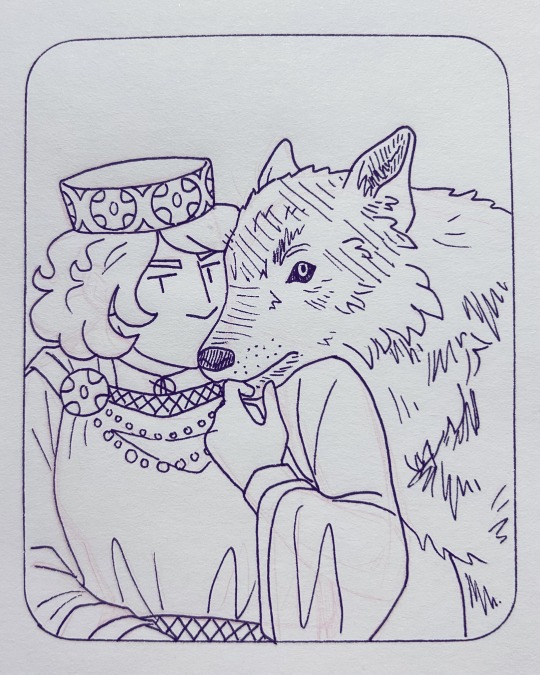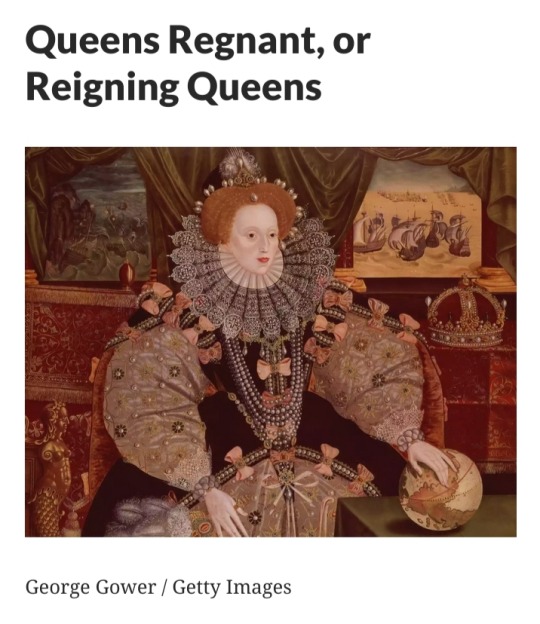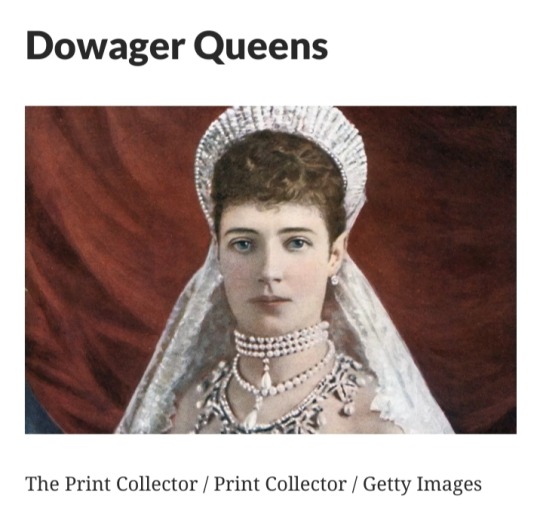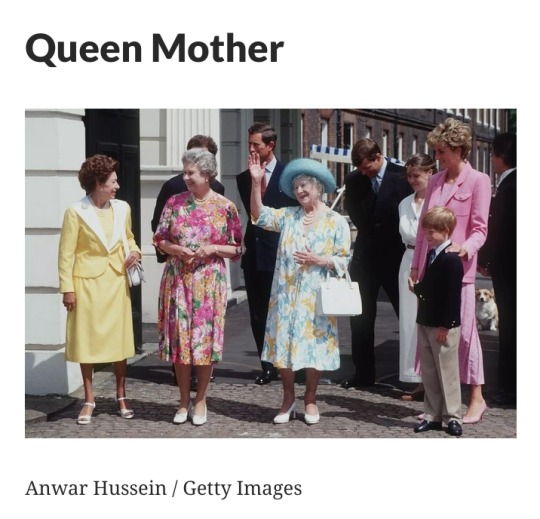#queen aelfthryth
Text

Day 28: Wolf - Aelfthryth, third wife of Edgar the Peaceful
#jenstober23#queen aelfthryth#edgar the peaceful#aethelred the unready#anglo saxon england#medieval england#saxon tag#wolf#10th century#history art#traditional art#inktober#inktober 2023#drawtober#drawtober 2023#artober#artober 2023#witchtober#witchtober 2023#day 28
8 notes
·
View notes
Text
The History of the Title of Queen
By: Jone Johnson Lewis, 18 November 2019
In English, the word for a female ruler is "queen," but that's also the word for the spouse of a male ruler.
Where did the title come from, and what are some variations on the title in common usage?

In English, the word “queen” apparently developed simply as a designation of the king's wife, from the word for wife, cwen.
It is a cognate with the Greek root gyne (as in gynecology, misogyny) meaning woman or wife, and with the Sanskrit janis meaning woman.
Among the Anglo-Saxon rulers of pre-Norman England, the historical record does not always even record the name of the king’s wife, as her position was not considered one requiring a title (and some of those kings had multiple wives, perhaps at the same time; monogamy was not universal at the time).
The position gradually evolves towards the current sense, with the word “queen.”
The first time a woman in England was crowned—with a coronation ceremony—as queen was in the 10th century CE:
The queen Aelfthryth or Elfrida, wife of King Edgar "the Peaceable," stepmother of Edward "the Martyr," and mother of King Ethelred (Aethelred) II "the Unready" or "Poorly Counseled."

English is unusual in having a word for female rulers that is rooted in a woman-oriented word.
In many languages, the word for a woman ruler is derived from a word for male rulers:
Roman Augusta (for women related to the emperor); emperors were titled Augustus.
Spanish reina; king is rey
French reine; king is roi
German for king and queen: König und Königin
German for emperor and empress: Kaiser und Kaiserin
Polish is król i królowa
Croatian is kralj i kraljica
Finnish is kuningas ja kuningatar
Scandinavian languages use a different word for king and queen, but the word for queen is derived from a word meaning “master”:
Swedish kung och drottning, Danish or Norwegian konge og dronning, Icelandic konungur og drottning
Hindi uses rājā and rānī; rānī derives from Sanskrit rājñī which is in turn derived from rājan for king, as is rājā

A queen consort is the wife of a reigning king.
The tradition of a separate coronation of a queen consort developed slowly and was unevenly applied.
Marie de Medici, for instance, was queen consort of King Henry IV of France.
There were only queens consort, no reigning queens of France, as French law assumed Salic Law for the sake of the royal title.
The first queen consort in England that we can find to have been crowned in a formal ceremony and coronation, Aelfthryth, lived in the 10th century CE.
Henry VIII infamously had six wives. Only the first two had formal coronations as queen, but the others were known as queens during the time their marriages endured.
Ancient Egypt didn't use a variation on the male rulership term, pharaoh, for queens consort.
They were called the Great Wife, or God's Wife.
In Egyptian theology, Pharaohs were considered incarnations of the gods.

A regent is someone who governs when the sovereign or monarch is unable to do so, due to being a minor, being absent from the country, or a disability.
Some queen consorts were briefly rulers in the stead of their husbands, sons or even grandsons, as regents for their male relative.
However, the power was supposed to return to the males when the minor child reached his majority or when the absent male returned.
The king's wife was often a choice for a regent, as she could be trusted to have the interests of her husband or son as a priority, and be less likely than one of many nobles to turn on the absent or minor or disabled king.
Isabella of France, English queen consort of Edward II and mother of Edward III, is infamous in history for having deposed her husband, later having him murdered, and then trying to hold on to the regency for her son even after he reached his majority.
The Wars of the Roses arguably began with disputes around the regency for Henry IV, whose mental condition kept him from ruling for some time.
Margaret of Anjou, his queen consort, played a very active and controversial role during Henry's periods described as insanity.
Although France did not recognize the right of a woman to inherit a royal title as queen, many French queens served as regents, including Louise of Savoy.

A queen regnant is a woman who rules in her own right, rather than exercising power as a wife of a king or even a regent.
Through most of history, succession was agnatic (through male heirs) with primogeniture being a common practice, where the eldest was first in succession (occasional systems where younger sons were preferred have also existed).
In the 12th century, Norman King Henry I, son of William the Conqueror, faced an unexpected dilemma near the end of his life:
His only surviving legitimate son died when his ship capsized en route from the continent to the island.
William had his nobles swear support for his daughter’s right to rule in her own right: Empress Matilda, already widowed from her first marriage to the Holy Roman Emperor.
When Henry I died, many of the nobles supported her cousin Stephen instead, and a civil war ensued, with Matilda never being formally crowned as queen regnant.
In the 16th century, consider the effect of such rules on Henry VIII and his multiple marriages, probably largely inspired by trying to get a male heir when he and his first wife Catherine of Aragon had only a living daughter, no sons.
On the death of Henry VIII’s son, King Edward VI, Protestant supporters tried to install the 16-year-old Lady Jane Grey as queen.
Edward had been persuaded by his advisors to name her as his successor, contrary to his father’s preference that Henry’s two daughters would be given preference in succession, even though his marriages to their mothers had been annulled and the daughters declared, at various times, to be illegitimate.
However, that effort was abortive, and after just nine days, Henry’s elder daughter, Mary, was declared queen as Mary I, England’s first queen regnant.
Other women, through Queen Elizabeth II, have been queen's regnant in England and Great Britain.
Some European legal traditions prohibited women from inheriting lands, titles and offices.
This tradition, known as Salic Law, was followed in France, and there were no queens regnant in France’s history.
Spain followed Salic Law at times, leading to a 19th-century conflict over whether Isabella II could reign.
In the early 12th century, Urraca of Leon and Castile ruled in her own right. Later, Queen Isabella ruled Leon and Castile in her own right and Aragon as co-ruler with Ferdinand.
Isabella’s daughter, Juana, was the only remaining heir at Isabella’s death. She became the queen of Leon and Castile, while Ferdinand continued to rule Aragon until his death.
In the 19th century, Queen Victoria's firstborn was a daughter. Victoria did later have a son who then moved ahead of his sister in the royal queue.
In the 20th and 21st centuries, several royal houses of Europe have removed the male-preference rule from their succession rules.

A dowager is a widow holding a title or property that was her late husband's.
The root word is also found in the word "endow."
Among the British peerage, a dowager continues to use the female form of her late husband's title so long as the present male title-holder does not have a wife.
When the present male title-holder marries, his wife assumes the female form of his title and the title used by the dowager is the female title prepended with Dowager ("Dowager Countess of ...") or by using her first name before the title ("Jane, Countess of ...").
The title "Dowager Princess of Wales" or "Princess Dowager of Wales" was given to Catherine of Aragon when Henry VIII arranged to annul their marriage.
This title refers to Catherine's previous marriage to Henry's older brother, Arthur, who was still Prince of Wales at his death, widowing Catherine.
At the time of the marriage of Catherine and Henry, it was alleged that Arthur and Catherine had not consummated their marriage due to their youth, freeing Henry and Catherine to avoid the church prohibition on marriage to one's brother's widow.
At the time Henry wanted to obtain an annulment of the marriage, he alleged that Arthur and Catherine's marriage had been valid, providing grounds for the annulment.

A dowager queen whose son or daughter is currently ruling is called a Queen Mother.
Several recent British queens have been called Queen Mother.
Queen Mary of Teck, mother of Edward VIII and George VI, was popular and known for her intelligence.
Elizabeth Bowes-Lyon, who did not know when she married that her brother-in-law would be pressured to abdicate and that she would become queen, was widowed when George VI died in 1952.
As the mother of the reigning Queen Elizabeth II, she was known as Queen Mum until her death 50 years later in 2002.
When the first Tudor king, Henry VII, was crowned, his mother, Margaret Beaufort, acted much as if she were the Queen Mother, though because she had never been a queen herself, the title Queen Mother was not official.
Some queen mothers were also regents for their sons if the son was not yet of age to take on the monarchy, or when their sons were out of the country and unable to rule directly.
21 notes
·
View notes
Text
18th March
St Edward the Martyr’s Day

Edward the Martyr. Source: Alamy Stock Photos
On this day in 979, the descriptively named Edward the Martyr was murdered. Edward was king of the relatively recently united England, but his legitimacy to succeed his father King Edgar was not uncontested. On the day of his death, Edward was enjoying a boar hunt and stopped at the manor of his step mother, Dowager Queen AElfthryth at Corfe Gate on the Isle of Purbeck in Dorset, who greeted him and offered the young man a refreshing cup of wine. As the king drank however, a hired assassin crept up behind him and stabbed him - literally - in the back. On feeling the blow, the surprised king instinctively spurred his horse forward to escape the attack, but the assassin had done his work. Edward tumbled dying from the horse and was dragged along the ground by a single stirrup as his steed bolted. His body was never found. AElfthryth however issued the story that Edward had been killed in a riding accident and ensured her son, Aethelred assumed the throne.
This Shakespearean story of murder most foul was not over however. The road between Corfe and Wareham in succeeding years became a place of miracles on which blind men found they could see, cripples were able to walk, and the deaf found they could hear. These phenomena were attributed to Edward and so gravediggers were sent to investigate. Edward’s body was found in a shallow roadside grave, in pristine condition and his tell-tale wound clearly visible. The former king was duly canonised and declared a martyr and his relics became a centre of pilgrimage in Shaftesbury. Although no charges were ever brought against AElfthryth, public opinion had no doubt, and the dowager queen ended her days in repentance as a nun at Wherwell in Hampshire. As for her son, he did not enjoy a happy reign - he was corrupt and weak and would be besieged by Viking invaders. He became known to history as Aethelred the Unready.
0 notes
Text
So, I’m looking at Anglo-Saxon names (I wanted to know why so many Anglo-Saxon queens were named Elf-something [Aelfgifu, Aelfthryth, etc]). It turns out that a lot of Anglo-Saxon names were dithematic: that means there are two parts of the name, and the meaning doesn’t really matter. You just pick one from column A and one from column B. Kind of like Eowyn, Eomer, and Eomund, or Theodred and Theoden, in Lord of the Rings.
So I was like, Ooo, you could make a list of the elements for a name generator! Some elements were only used in column A, and some were only used in column B, but some could be used in either column.
And then I realized that one of those elements that could be used in either place was ‘Wulf’ (wolf).
You could theoretically end up with the name Wulfwulf.
....
MOON MOON LIVES!

17 notes
·
View notes
Note
So, was WL Y/N really stuck in her marriage either way? Because her titles only came bc of Ivar and she had a humble upbringing? How did it work during those times?
Hey hun.❤
You're absolutley correct. Reader's titles are only bestowed in nature. For that reason she had no rights to keep them nor any of the privileges that came with said titles.
True Nobilty were born into families with grest lineages. This is why bloodlines were so important. Not simply to protect wealth, but to leverage alliances and other political endeavors.
Fun fact, even the Saxons didn't regard the wife of their Kings as "Queens".
Ealhswith - married to King Alfred the Great in 868. She was the daughter of Aethelred Mucil, a Mercian noble, and Eadburh, also a Mercian noble, supposedly descended from King Cenwulf of Mercia (ruled 796 – 812).
She was never actually given the title of “queen.”
Among their children were Aethelflaed, Lady of the Mercians; Aelfthryth, who married the Count of Flanders; and Edward, who succeeded his father as king.
Source
In the medieval war and even afterward, one could lose their position in society quite easily. And that wasn't simply fir the commoner. Unless traceable through lineage, titles, wealth and land could be stripped.
If you want to know more, here are some awesome resources:
8 notes
·
View notes
Text
frystavirki replied to your post “bored with a couple hours before bed so give me a queen (consort or...”
aelfthryth?
she’s holding her son’s badly drawn crown because he’s like 12

6 notes
·
View notes
Text
100 Days of Writing - Day 3
@the-wip-project asked about motivations of our characters, but seeing as I'll be focusing on several stories, I think I'm going to go about today's post as something slightly different, and focus on one of my original fics, specifically Two Ways From Sunday, which @barbex commented on yesterday.
Two Ways From Sunday
So, as I mentioned yesterday, this is a piece of original fiction that developed out of my Master's Thesis in grad school. My Master's Theses was on the history of Amesbury Abbey in Amesbury England. Like many abbeys throughout history, it has a long, sometimes unexpected history. A Benedictine abbey founded in 979 by Queen AElfthryth, supposedly in pennance for the murder of her stepson, it is also supposedly the abbey where Guenivere retreated with Excalibur until King Arthur came looking for it.
Around 1177, King Henry II and Queen Eleanor of Aquitaine decided to 'refound' it - making it an abbey of the Fontevrault order that originates out of their lands in France. The reson for the refounding (aside from the normal patronage of the nobility in the middle ages, seeking ways into heaven) actually has more to do with murder (I'll get to that in a minute). Instead of going on Crusade as he had promised the Pope, King Henry decided to 'refound' three monasteries, of which Amesbury was one. But to do so, they needed a 'good reason' to kick out the Benedictines and take it over. As with most things political, that reason involves fabricated charges, in this case against the nuns currently living there.
(under cut due to length)
When you're the king of England, it's easy to get the Church on your side, as you can imagine, so it was only a matter of time. (mostly, the reason appears to be that Amesbury's original foundation was an 'independent' monastery (though not as large and powerful as other nunneries in the country)) Charges were created against the women there and in 1177, they were forced out and the new nuns brought in. NBD for the king, this happens throughout history.
However, in looking deeper into the history, it's interesting to note that the actual reason is likely more of a pennance for Henry and his part in the murder of Thomas Beckett, who was killed December 29, 1170. I won't go into details here, but suffice it to say, I found it a fascinating idea, and as I looked into it further while doing research, it's one I fully believe is behind the transition.
Also, during graduate school my advisor turned me on to reading the Brother Cadfael medieval mystery series (interesting side note: I actually got to meet Ellis Peters before she died, purely by chance!) and I was hooked. So, during my Thesis defense, when I was speaking to both my advisor and the literature professor (her best friend) afterward, the topic of how Amesbury Abbey making a great plot for a medieval mystery novel came up. I agreed wholeheartedly, but shuffle it off to the back burner because Real Life. I had to worry about finding a teaching job and surviving on my own first.
That was in April of 1993.
Over the years, I made several attempts to plot out an idea for it, most of which came to nothing, but I held onto the ideas and toyed with them every five years or so.
In November of 2017, I finally sat down and wrote (most of) the first draft of book 1 - Two Ways From Sunday. The setting is in 1170 and it begins with the original Saxon order still in control of the abbey. It's Christmas time, and, seeing as I love mysteries and in tribute to my professors and Ellis Peters, a Murder occurs, woven in amongs a Plot by people who do not support Henry, and then the death of Beckett sort of tops it all off. (No, he's not the murder being investigated)
The main character of the story is a young nun (roughly in her 20s) named Gemma. Her twin brother, his new wife, and an old family friend that Gemma knows as well come to visit and spend Christmas at the abbey. After the murder occurs, Abbess Beatrice asks Robert (Gemma's twin) and Stephen (family friend) as well as Gemma and Sister Ursula to investigate. What they follow is twisted trail through political intrigue on a far grander scale than expected, ultimately involving the king. (I am terrible at summaries, my apologies!)
If I can ever get this story whipped into shape, I intend to move on with Gemma's story which I started in book 2. I think in all, I have around ten books planned, though whether or not they all get written remains to be seen.
This time around for Camp Nano, my intention is to focus on filling in the missing bits (I didn't realize I'd left quite so many "oh this goes here" type of notes in it! lol), fleshing out the characters a bit more, and just generally polishing the story so it reads better. I'm not sure I can get everything I want to do accomplished in a month's time, especially with other projects going on, but the fact that this particular story has been percolating for so long and is finally cathing my interest again is a good sign, I think.
Ultimately, my goal is to get the story published, but even if I don't, I'll be happy to finally finish it to a point where I feel satisfied with it and able to move onto the next one without looking back. This story is also special to me because my mother was one of my greatest supporters during graduate school. She knew the literature professor well from her own studies (Mom was getting her second MA at the same time I was getting my first) and she was my Latin translator. She also played a large part in me getting to meet Ellis Peters, too. Two Ways From Sunday was written the fall after Mom passed away from a very aggressive and unexpected form of cancer, and I've always felt she was guiding my hand that year with my writing. I'd love to be able to get the story done for her. She's the one who fed my love of mysteries from a young age, having me read Agatha Christie for a book report when I was twelve. :)
#100daysofwriting#ladya writes#the wip project#Two Ways From Sunday#original fic#my original fic#medieval mystery fic#historical fic#my apologies I'm a bit passionate about the study of history! lol
11 notes
·
View notes
Text
Have your stepson murdered so that your own son can become king
#anglo saxons#anglo saxon history#edward the martyr#queen aelfthryth#queen elfrida#aethelred ii#aethelred the unready#ethelred the unready
39 notes
·
View notes